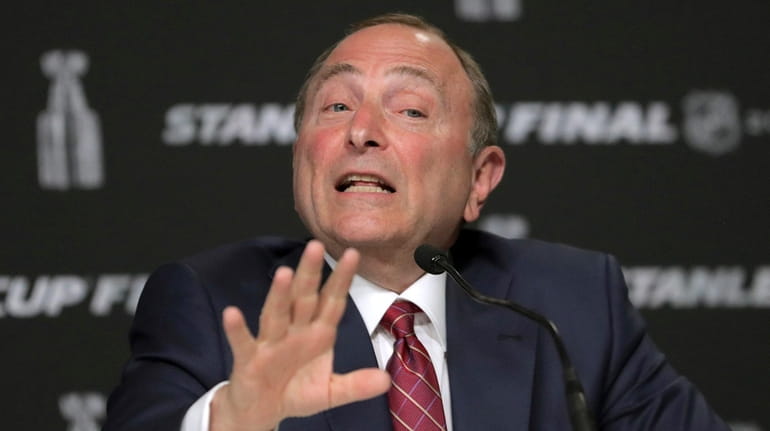Unlike in past, labor peace was paramount to the NHL and its players amid pandemic

FILE - In this May 27, 2019, file photo, NHL Commissioner Gary Bettman speaks to the media before Game 1 of the NHL hockey Stanley Cup Final between the St. Louis Blues and the Boston Bruins in Boston. The most aggressive timetable, a person familiar with discussions told The Associated Press, would have players returning to their home rinks as early as May 15, followed by a training camp and possible exhibition games in June. Bettman emphasized no decisions have been made and cautioned government and medical officials will ultimately make the call on when sports can return. (AP Photo/Charles Krupa, File) Credit: AP/Charles Krupa
They read the room.
The NHL-NHL Players’ Association relationship has not often been one associated with long-term labor peace. But faced with an unprecedented crisis in the COVID-19 pandemic, NHL commissioner Gary Bettman and NHLPA executive director Don Fehr knew this was not the time to squabble.
Et voila, about four months of intense negotiations spurred by the pause of the season on March 12, we have peace in our time: a four-year collective bargaining agreement extension through 2026 that goes hand-in-hand with the return-to-play agreement to try to complete the Stanley Cup playoffs.
“This time, Don and I both recognized labor peace was something that we couldn’t even quantify how important it was,” Bettman said Saturday on a joint NHL-NHLPA teleconference after both sides ratified the agreement on Friday. “There was enough disruption going on in the world. We didn’t need to add to it.”
Bettman’s subsequent statement that he’s “always believed labor peace is important . . . labor disruptions are just that, disruptive. You try to avoid them; sometimes you just can’t” probably should have been met with cynical guffaws. After all, under Bettman’s watch, owners’ lockouts wiped out the full 2004-05 season and limited 1994-95 and 2012-13 to 48 games.
And let’s face it, the players are giving up more under this CBA to keep the peace than the owners are, even if the players got the wanted concession of returning to Olympic participation in 2022 and 2026 for the first time since 2014. The owners, with a 50-50 split of hockey-related revenue in the current CBA that was always a bad deal for the NHLPA, could turn to the players to recoup some of their losses.
The NHL plans to play a full 82-game 2020-21 season starting Dec. 1. But there’s no guarantee that fans will be back in the stands by then.
Yet Bettman does deserve credit here for a collaborative effort with Fehr.
“We’re living in difficult times, uncertain times,” Fehr said on the same teleconference. “Nobody knows what the future would bring. This could not be normal collective bargaining.”
Fehr readily admits this is not a perfect CBA from a players’ perspective — escrow remaining the main offender — but rather an attempt to shape a long-term agreement to address what is expected to be a long-term financial impact from the pandemic.
“You have to put the game on the best possible footing to recover as quickly as possible when the economy comes back,” Fehr said. “I think we did that.”
Time, of course, will tell whether the players will grow increasingly unhappy under the CBA extension. The goal is to return the league’s revenues to the $4.8 billion that had been projected for this season but, by design, there will be little growth in the salary cap through the life of this CBA.
The salary cap will be flat next season at $81.5 million with player escrow at 20% and players also will defer 10% of their salaries for the 2020-21 season to be paid out in equal installments over three seasons beginning in 2022-23.
The net result will be a tightening of the free-agent market as cap-strapped teams are unable to offer deals to players they thought they’d be able to keep.
Which is all the more reason to praise the NHLPA’s willingness to not play hardball and to work within an escrow-based system to arrive at a deal both sides could accept. We all know how out of touch Major League Baseball and its players’ union appeared as they bickered over the restart to their season. Now they face a real labor battle at the most inopportune time.
One thing the NHLPA was adamant about in negotiations was the need for medical privacy in reporting COVID-19 test results.
So while the NHL will continue to release the overall numbers in its COVID-19 testing of players, players who test positive won’t be individually identified. In an effort to reduce speculation about who may or may not have coronavirus, there will be no reporting of injuries. No more upper- or lower-body designations. If a player is not in the lineup or not at practice, he’s just not there — no explanation forthcoming.
“It was a high priority for guys, no question,” said Mathieu Schneider, the NHLPA’s special assistant to the executive director. “Guys are very sensitive to it.”
The players also were adamant about wanting to maintain the best-of-seven series format for all four rounds of the playoffs. Bettman said best-of-five series initially were discussed for the first two rounds to limit the time spent in a quarantined hub city.
“That, to me, was impressive,” Bettman said. “The integrity of the return-to-play system was paramount in everybody’s mind.”
The sides are quick to praise each other these days, a far cry from their past public differences.
Will the mutual admiration last? That’s still to be seen. Or heard. For now, though, both sides being able to read the room is enough.

